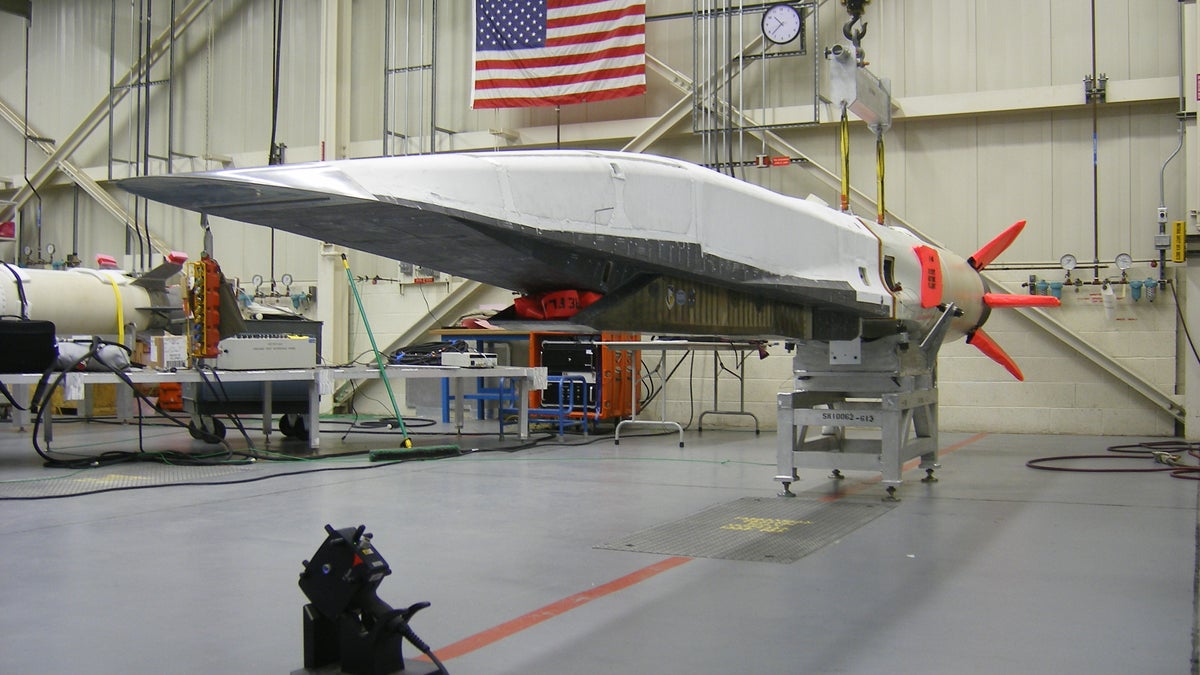Futuristic X-51A fails in hypersonic bid
Trouble with a control fin on the sleek, scramjet-powered aircraft puts an abrupt and early end to the Air Force's attempt at a Mach 6 flight.

No one ever said it would be easy going Mach 6.
The U.S. Air Force's experimental X-51A Waverider failed yesterday in its bid to hit that hypersonic speed. Although the aircraft did separate as planned from its B-52 mother ship in midair, things quickly went wrong. Today's official Air Force statement, issued just minutes ago, describes things this way:
The X-51 safely separated from the B-52 and the rocket booster fired as planned. However after 16 seconds, a fault was identified with one of the cruiser control fins. Once the X-51 separated from the rocket booster, approximately 15 seconds later, the cruiser was not able to maintain control due to the faulty control fin and was lost.
The X-51A was supposed to fly for 300 seconds (that is, five minutes). The unmanned aircraft likely crashed into the Pacific Ocean -- which was, essentially, the planned end for the Waverider's one-way flight, just not so abruptly.
Separation from the B-52 occurred over Point Mugu Naval Air Warfare Center Sea Range Aug. 14 at approximately 11:36 a.m. PST.
"It is unfortunate that a problem with this subsystem caused a termination before we could light the scramjet engine," said Charlie Brink, X-51A program manager for Air Force Research Laboratory, in a statement. "All our data showed we had created the right conditions for engine ignition and we were very hopeful to meet our test objectives."
This was the third attempt by the Air Force at getting an X-51A airframe to go hypersonic; a first flight in May 2010 did achieve some measure of success. Hypersonic flight occurs when an aircraft exceeds Mach 5, or five times the speed of sound.
The X-51A gets its Waverider name from an aspect of the aircraft's expected performance in flight -- essentially, once it's moving fast enough, it surfs its own shockwave.
The Air Force calls the X-51A a technology demonstrator, not a prototype for any particular weapon system. What it's intended to demonstrate is the feasibility of futuristic scramjet technology, which could someday lead to hypersonic weapons (think cruise missiles, but much faster) or reconnaissance vehicles, or cheaper and less bulky ways to get spacecraft out of the atmosphere.
In May 2010, an X-51A nibbled at the edge of hypersonic flight, if only just barely and ever so briefly. Pushed by its scramjet engine, that test vehicle accelerated "to approximately Mach 5, nearly 3,400 miles per hour," according to the U.S. Air Force's X-51A fact sheet, echoing the branch's speed claims at the time. It flew "as anticipated for nearly 200 seconds" (3 minutes, 20 seconds), the Air Force says, though it transmitted normal telemetry data for just over 140 seconds, then lost thrust and acceleration, and an "anomaly" prompted ground controllers to destroy the aircraft. (In today's statement, the Air Force now says that the May 2010 flight reached a speed of Mach 4.88.)
As with today's flight, that test run had been expected to last a full 300 seconds and to achieve Mach 6.
"Despite the anomaly," the Air Force says on the fact sheet, choosing its words carefully, "the May 26 [2010] flight is considered the first use of a practical hydrocarbon fueled scramjet in flight."
A second X-51A flight in 2011 petered out quickly. Boeing and its fellow contractors built four X-51A vehicles, so at this point there's only one left to go. All of the 25-foot-long, 4,000-pound aircraft were intended to be disposable: one flight and done.
The Air Force said today that it has not yet decided whether that last X-51A airframe will fly.
Before the X-51A can make its hypersonic run, it first gets off the ground tucked under the wing of a B-52. The mother ship lets go at about 50,000 feet, and a rocket booster then kicks the Waverider up to about Mach 4.5. That booster drops off and the Pratt & Whitney Rocketdyne scramjet (short for "supersonic combustion ramjet") engine takes over, and it's really off to the races at that point. A scramjet engine is designed to burn oxygen from the atmosphere, spritzed with a dash of jet fuel, unlike conventional rocket engines that a combination of oxidizers and big fuel tanks.
In November 2004, NASA's scramjet-powered hypersonic X-43A flew faster, hitting Mach 9.8, but only for about 10 to 12 seconds.
CNN headlined its preview story about today's X-51A flight "Imagine flying from New York to London in under an hour," and other reports took the same "What's it mean for Joe Vacationer and Jane Business-Traveler" tack. But forget about trying to book tickets anytime soon. We'll probably see one-hour cross-country flights about as soon as astronauts are commuting to and from Mars.
For the challenging scramjet technology, there are surely many more years of experimental flights before there might even be a test pilot getting into an eventual X-51A follow-on, let alone passengers.

